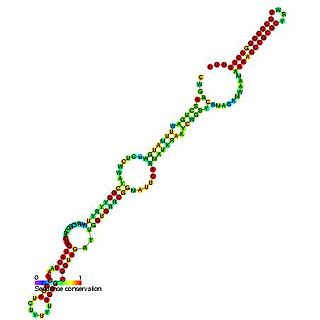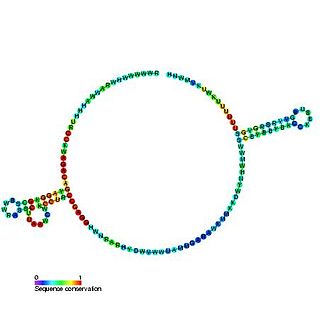
Ribosomal ribonucleic acid (rRNA) is the RNA component of the ribosome, and is essential for protein synthesis in all living organisms. It constitutes the predominant material within the ribosome, which is approximately 60% rRNA and 40% protein by weight, or 3/5 of ribosome mass. Ribosomes contain two major rRNAs and 50 or more proteins. The ribosomal RNAs form two subunits, the large subunit (LSU) and small subunit (SSU). The LSU rRNA acts as a ribozyme, catalyzing peptide bond formation. The SSU and LSU rRNA sequences are widely used for working out evolutionary relationships among organisms, since they are of ancient origin and are found in all known forms of life.
Attenuation is a proposed mechanism of control in some bacterial operons which results in premature termination of transcription and is based on the fact that, in bacteria, transcription and translation proceed simultaneously. Attenuation involves a provisional stop signal (attenuator), located in the DNA segment that corresponds to the leader sequence of mRNA. During attenuation, the ribosome becomes stalled (delayed) in the attenuator region in the mRNA leader. Depending on the metabolic conditions, the attenuator either stops transcription at that point or allows read-through to the structural gene part of the mRNA and synthesis of the appropriate protein.

The trp operon is an operon—a group of genes that is used, or transcribed, together—that codes for the components for production of tryptophan. The trp operon is present in many bacteria, but was first characterized in Escherichia coli. The operon is regulated so that when tryptophan is present in the environment, the genes for tryptophan synthesis are not expressed. It was an important experimental system for learning about gene regulation, and is commonly used to teach gene regulation.

The Tryptophan operon leader is an RNA element found at the 5' of some bacterial tryptophan operons. The leader sequence can assume two different secondary structures known as the terminator and the anti-terminator structure. The leader also codes for very short peptide sequence that is rich in tryptophan. The terminator structure is recognised as a termination signal for RNA polymerase and the operon is not transcribed. This structure forms when the cell has an excess of tryptophan and ribosome movement over the leader transcript is not impeded. When there is a deficiency of the charged tryptophanyl tRNA the ribosome translating the leader peptide stalls and the antiterminator structure can form. This allows RNA polymerase to transcribe the operon.

The Leucine operon leader is an RNA element found upstream of the first gene in the Leucine biosynthetic operon. The leader sequence can assume two different secondary structures known as the terminator and the anti-terminator structure. The leader also codes for very short peptide sequence that is rich in leucine amino acid. The terminator structure is recognised as a termination signal for RNA polymerase and the operon is not transcribed. This structure forms when the cell has an excess of leucine and ribosome movement over the leader transcript is not impeded. When there is a deficiency of the charged leucyl tRNA the ribosome translating the leader peptide stalls and the antiterminator structure can form. This allows RNA polymerase to transcribe the operon. At least 6 amino acid operons are known to be regulated by attenuation.

This family is a putative ribosomal protein leader autoregulatory structure found in B. subtilis and other low-GC Gram-positive bacteria. It is located in the 5' untranslated regions of mRNAs encoding ribosomal proteins L10 and L12 (rplJ-rplL). A Rho-independent transcription terminator structure that is probably involved in regulation is included at the 3' end.

This family is a putative ribosomal protein leader autoregulatory structure found in B. subtilis and other low-GC Gram-positive bacteria. It is located in the 5' untranslated regions of mRNAs encoding the L13-S9 (rplM-rpsI) ribosomal protein operon.

This family is a putative ribosomal protein leader autoregulatory structure found in B. subtilis and other low-GC Gram-positive bacteria. It is located in the 5' untranslated regions of mRNAs encoding initiation factor 3 followed by ribosomal proteins L35 and L20 (infC-rpmI-rplT). A Rho-independent transcription terminator structure that is probably involved in regulation is included at the 3' end.

The Histidine operon leader is an RNA element found in the bacterial histidine operon. At least 6 amino acid operons are known to be regulated by attenuation. In each a leader sequence of 150-200 bp is found upstream of the first gene in the operon. This leader sequence can assume two different secondary structures known as the terminator and the anti-terminator structure. In each case the leader also codes for very short peptide sequence that is rich in the end product amino acid of the operon. The terminator structure is recognised as a termination signal for RNA polymerase and the operon is not transcribed. This structure forms when the cell has an excess of the regulatory amino acid and ribosome movement over the leader transcript is not impeded. When there is a deficiency of the charged tRNA of the regulatory amino acid the ribosome translating the leader peptide stalls and the antiterminator structure can form. This allows RNA polymerase to transcribe the operon.

The threonine operon leader is an RNA element. Threonine is one of at least 6 amino acid operons are known to be regulated by attenuation. In each a leader sequence of 150-200 bp is found upstream of the first gene in the operon. This leader sequence can assume two different secondary structures known as the terminator and the anti-terminator structure. In each case the leader also codes for very short peptide sequence that is rich in the end product amino acid of the operon. The terminator structure is recognised as a termination signal for RNA polymerase and the operon is not transcribed. This structure forms when the cell has an excess of the regulatory amino acid and ribosome movement over the leader transcript is not impeded. When there is a deficiency of the charged tRNA of the regulatory amino acid the ribosome translating the leader peptide stalls and the antiterminator structure can form. This allows RNA polymerase to transcribe the operon.

Pseudomonas sRNA P26 is a ncRNA that was predicted using bioinformatic tools in the genome of the opportunistic pathogen Pseudomonas aeruginosa and its expression verified by northern blot analysis. P26 is conserved across many Gammaproteobacteria species and appears to be consistently located between the DNA directed RNA polymerase and 50S ribosomal protein L7/L12 genes.

The L17 downstream element RNA motif is a conserved RNA structure identified in bacteria by bioinformatics. All known L17 downstream elements were detected immediately downstream of genes encoding the L17 subunit of the ribosome, and therefore might be in the 3' untranslated regions of these genes. The element is found in a variety of lactic acid bacteria and in the genus Listeria.

The rmf RNA motif is a conserved RNA structure that was originally detected using bioinformatics. rmf RNAs are consistently foundwithin species classified into the genus Pseudomonas, and is located potentially in the 5' untranslated regions of rmf genes. These genes encodes the ribosome modulation factor protein, which affects the translation of genes by modifying ribosome structure in response to stress such as starvation. This ribosome modulation is a part of the stringent response in bacteria. The likely biological role of rmf RNAs is ambiguous. Since the RNA could be in the 5' UTRs of protein-coding genes, it was hypothesized that it functions as a cis-regulatory element. This hypothesis is bolstered by the observation that ribosome modulation factor binds ribosomal RNA, and many cis-regulatory RNAs called ribosomal protein leaders participate in a feedback regulation mechanism by binding to proteins that normally bind to ribosomal RNA. However, since rmf RNAs are not very close to the rmf genes, they might function as non-coding RNAs.

A long range pseudoknot is a pseudoknot containing a long loop region, and may be a mechanism of translational control.

The Pseudomonas rnk leader is a putative attenuator element identified by bioinformatics within bacteria of the γ-proteobacterial Pseudomonas genus. It is located upstream of the rnk gene, encoding a nucleoside diphosphate kinase regulator, and presents a Rho-independent terminator at the 3' end. This RNA is presumed to operate as a non-coding leader, which regulatory mechanism remains to be elucidated. The motif might be related to other rnk-and greA-leaders, such the Enterobacteria rnk leader and Enterobacteria greA leader.

The Rickettsia rpsL leader is a putative attenuator element identified by bioinformatics within bacteria of the α-proteobacterial Rickettsia genus. It is located upstream of the operon encoding ribosomal proteins S12 and S7, and presents a Rho-independent terminator at the 3' end. This RNA is presumed to operate as a non-coding ribosomal protein leader potentially interacting with the S12 or S7 proteins, encoded by the operon. The motif might be related to other rpsL leaders, such as that from Pseudomonas.
The Enterobacteria rnk leader is a putative attenuator element identified by bioinformatics within bacteria of the γ-proteobacterial Enterobacteriales order. It is located upstream of the rnk gene, encoding a nucleoside diphosphate kinase regulator, and presents a Rho-independent terminator at the 3' end. This RNA is presumed to operate as a non-coding leader, which regulatory mechanism remains to be elucidated. The motif might be related to other rnk-and greA-leaders, such as Pseudomonas rnk leader.

The Enterobacteria greA leader is a putative attenuator element identified by bioinformatics within bacteria of the γ-proteobacterial Enterobacteriales order. It is located upstream of the rnk gene, encoding a transcription elongation factor, and presents a Rho-independent terminator at the 3' end. This RNA is presumed to operate as a non-coding leader, which regulatory mechanism remains to be elucidated. The short abortive form of the greA transcript may also play a role as an independent sRNA: Potrykus et al. have shown that its overexpression leads to the repression of several genes. The motif might be related to other rnk leaders such as the Pseudomonas rnk leader and the Enterobacteria rnk leader.

The γ-proteobacterial rimP leader is a putative attenuator element identified by bioinformatics within bacteria of the γ-proteobacterial phylum. It is located upstream of the rimP-nusA-infB operon encoding RimP, a protein shown to be involved in the 30S ribosomal subunit maturation, NusA, a transcriptional factor controlling termination, and the translation initiation factor IF-2 respectively. The rimP-leader presents a Rho-independent terminator at the 3' end, corresponding to a highly conserved GGGc(...)gCCC motif. This motif is presumed to operate as a non-coding leader. Its mechanism remains unknown, but it is tempting to speculate a regulatory involvement of the NusA protein, which expression has been shown to lower the operon expression, and which is already involved in the attenuation of the Trp, His and S10 operons.
RpsF leader is a conserved RNA structure, widely distributed to many bacterial species. It precedes the operon containing rpsF and rpsR, which encode ribosomal protein S6 and ribosomal protein S18, respectively. The RNA was shown to interact with S6:S18 protein dimer in vitro. It was shown that RpsF leader regulates gene expression in response to the S6:S18 complex, contributing to the regulation of ribosomal protein levels.




















